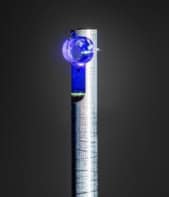Accurate measurements of the masses of nuclei are important in nuclear physics and tests of the Standard Model of particle physics. Now, an international team working at the ISOLTRAP mass spectrometer at CERN has determined the masses of two isotopes of argon with the highest precision ever (K Blaum et al. 2004 Phys. Rev. Lett. 91 260801).
The “Segrè chart” in nuclear physics is a plot of proton number versus neutron number. Stable nuclei tend to have about the same number of protons and neutrons and form the so-called valley of stability, although heavier stable nuclei tend to have more neutrons than protons. The valley of stability is bordered by regions containing short-lived nuclei that decay into more stable isotopes through a variety of different mechanisms. In neutron-rich nuclei, a neutron can decay into a proton, an electron and an antineutrino. And in proton-rich nuclei – like argon-32 and 33 – a proton decays into a neutron, a positron and a neutrino.
When the argon nuclei undergo beta decay the positrons and neutrinos are not emitted isotropically in space, but at an angle to each other. This angular correlation can be characterised by a “beta-neutrino correlation coefficient”, which can be used to place constraints on aspects of the weak interaction that are not included in the Standard Model. However, this requires accurate values for the masses of the nuclei involved in the decay.
Previously researchers had to calculate this coefficient using masses derived from theory because experiments were not accurate enough. However, Klaus Blaum and co-workers have now measured the masses of argon-32 and argon-33 with an accuracy that is an order of magnitude better than previous results. The new results could therefore be used to calculate improved values of the beta-neutrino coefficient.
The ISOLTRAP mass spectrometer consists of a radiofrequency quadrupole ion trap and two “Penning” traps. The improvement in accuracy is mostly due to the addition of a new carbon-cluster source to the device. The atomic mass unit is defined in terms of the mass of a carbon-12 atom, so the new carbon source allows the absolute masses of the argon nuclei to be determined. The team now hopes to measure other “exotic” nuclei, such as magnesium-22 and gallium-62.



